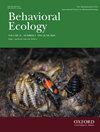食物的数量和报警信号的强度共同调节白蚁的资源选择
IF 2.5
3区 环境科学与生态学
Q2 BEHAVIORAL SCIENCES
引用次数: 0
摘要
在最大限度地增加食物摄入量的同时降低风险是大多数动物觅食行为的重要权衡。一般来说,觅食者是脆弱的,在收益(食物数量)和成本(被杀死的风险)之间进行权衡的能力可能会提供相当大的生态优势。尽管研究越来越多,但对食物数量和死亡风险信号对真社会性昆虫资源选择的影响尚不清楚。本文研究了不同食物量和不同报警信号强度对新热带白蚁(Nasutitermes corniger, Motschulsky)资源选择的影响。采用二选法和多选法对不同食物量和不同报警信号的资源进行操作生物测定,观察白蚁种群的招募情况。总的来说,我们的研究结果表明,无论食物数量如何,只要有少量的警报信号,白蚁就会避开食物来源。这项工作有助于更好地了解白蚁物种对栖息地的利用。此外,该研究还首次揭示了食物数量和警报信号对一种重要的生态和经济白蚁资源选择的综合影响。本文章由计算机程序翻译,如有差异,请以英文原文为准。
Food quantity and the intensity of the alarm signal combine to modulate the resource selection in a termite species
Abstract Maximizing food intake while minimizing risk is an important trade-off in the foraging behavior of most animals. In general, foragers are vulnerable and the ability to trade off benefits (food quantity) against costs (risk of being killed) may provide a considerable ecological advantage. Despite the increasing number of studies, the effects of food quantity and mortality risk signals on resource selection in eusocial insect is not well understood. Here, we investigated the combination of distinct levels of food quantity and the intensity of alarm signal on resource selection of a Neotropical termite, Nasutitermes corniger (Motschulsky) (Termitidae: Nasutitermitinae). Manipulative bioassays with binary and multiple choices were conducted over time to check the recruitment of termite groups among resources containing different levels of food quantity and alarm signals. Overall, our results showed that regardless of food quantity, termites avoid a food source if there is even a small amount of alarm signal. This work contributes to a better understanding of habitat use by termite species. Furthermore, it shows for the first time the combined effects of food quantity and alarm signals on the resource selection of an important ecological and economic termite species.
求助全文
通过发布文献求助,成功后即可免费获取论文全文。
去求助
来源期刊

Behavioral Ecology
环境科学-动物学
CiteScore
5.20
自引率
8.30%
发文量
93
审稿时长
3.0 months
期刊介绍:
Studies on the whole range of behaving organisms, including plants, invertebrates, vertebrates, and humans, are included.
Behavioral Ecology construes the field in its broadest sense to include 1) the use of ecological and evolutionary processes to explain the occurrence and adaptive significance of behavior patterns; 2) the use of behavioral processes to predict ecological patterns, and 3) empirical, comparative analyses relating behavior to the environment in which it occurs.
 求助内容:
求助内容: 应助结果提醒方式:
应助结果提醒方式:


